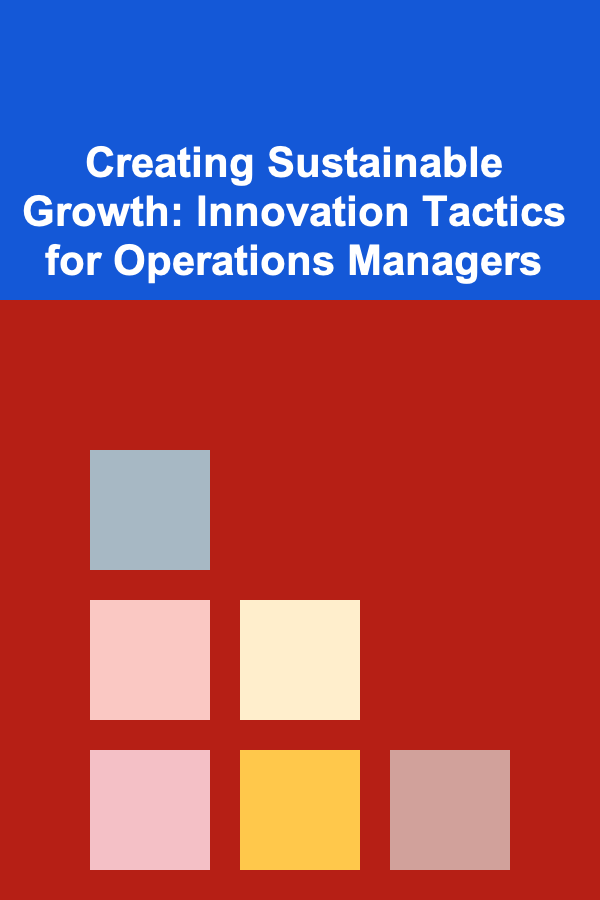
Creating Sustainable Growth: Innovation Tactics for Operations Managers
ebook include PDF & Audio bundle (Micro Guide)
$12.99$5.99
Limited Time Offer! Order within the next:

In the competitive landscape of modern business, operations managers play a crucial role in driving sustainable growth within an organization. Their responsibility extends far beyond day-to-day management tasks; they are the architects of efficiency, cost-effectiveness, and strategic decision-making. One of the most effective ways operations managers can ensure long-term success is through innovation.
Innovation isn't just about creating new products or services; it's also about improving processes, finding smarter ways to solve problems, and adapting to the changing needs of both the market and the workforce. In this guide, we'll explore actionable innovation tactics that operations managers can implement to create sustainable growth in their organizations.
Embrace Lean Thinking and Continuous Improvement
Why Lean Thinking?
Lean thinking revolves around the concept of maximizing value by minimizing waste. This philosophy is essential for improving efficiency, cutting costs, and fostering innovation. By continuously striving for perfection in all processes, organizations can drive consistent growth.
Actionable Tactics:
- Identify Bottlenecks: Start by mapping out your operations. Identify where inefficiencies exist, such as production delays, excessive costs, or poor communication. Use tools like Value Stream Mapping (VSM) to highlight these bottlenecks.
- Kaizen (Continuous Improvement): Implement the Kaizen philosophy, which encourages small, incremental changes that collectively lead to significant improvements over time. Encourage employees to suggest improvements, which fosters a culture of innovation and ownership.
- Focus on Process Standardization: While creativity is key, standardizing repeatable tasks leads to greater efficiency. Define clear processes and standard operating procedures (SOPs), ensuring consistency and predictability in operations.
- Waste Reduction: Apply the "7 Wastes of Lean" (overproduction, waiting, transportation, unnecessary inventory, over-processing, defects, and unused talent) to identify areas for waste reduction in your operations.
By embracing Lean principles, you create a foundation of sustainable efficiency that can fuel long-term growth. Lean not only helps reduce costs but also lays the groundwork for innovative practices to thrive within your organization.
Leverage Technology for Automation and Data-Driven Decisions
The Power of Technology
The digital transformation of industries is accelerating. From artificial intelligence (AI) to machine learning, robotics, and big data analytics, the operational landscape is becoming increasingly reliant on technology. Innovation doesn't always require human ingenuity alone---it can also come from the strategic use of cutting-edge tools that optimize performance.
Actionable Tactics:
- Automation of Repetitive Tasks: Identify repetitive, manual tasks that are prone to errors or inefficiencies. Implement robotic process automation (RPA) or software tools to streamline these processes. For example, automating inventory management or payroll can free up resources to focus on higher-value activities.
- Data Analytics and Predictive Insights: Use data analytics platforms to extract actionable insights from your data. Predictive analytics can help you forecast demand, optimize inventory, and improve supply chain management. Tools like Tableau, Power BI, or advanced ERP systems can aggregate real-time data to inform decision-making.
- Implement AI and Machine Learning: AI and machine learning can enhance decision-making and streamline operations. For instance, AI can be used to predict machine breakdowns in manufacturing or optimize delivery routes in logistics, reducing downtime and operational inefficiencies.
- Cloud-Based Platforms for Collaboration: Use cloud-based tools to improve collaboration among teams. Tools such as Slack, Microsoft Teams, and Asana allow real-time communication and project tracking, fostering innovation through cross-departmental collaboration.
The integration of technology in operations doesn't just increase productivity; it also provides a competitive edge in adapting to market shifts and meeting customer demands.
Foster a Culture of Innovation
Why Culture Matters?
A culture of innovation is vital for sustaining growth. When employees at all levels feel empowered to innovate, an organization can harness collective intelligence to solve problems, streamline processes, and explore new opportunities. Innovation is not just the responsibility of the R&D department; it should be embedded in every aspect of the organization.
Actionable Tactics:
- Encourage Risk-Taking: Create an environment where employees feel safe to experiment with new ideas without fear of failure. Recognize that failure is often a part of the learning process. Celebrate innovative efforts even if they don't always result in immediate success.
- Open Innovation: Engage employees in brainstorming sessions or innovation challenges. Involve your workforce in decision-making processes, giving them the opportunity to contribute ideas that can improve operations. Involving different perspectives can often lead to groundbreaking solutions.
- Innovation Labs or Teams: Create dedicated innovation teams or labs where employees can work on pilot projects or experimental initiatives. These teams should be tasked with exploring emerging trends, new technologies, and creative solutions for operational challenges.
- Provide Learning and Development: Offer training programs that encourage employees to think creatively. Workshops on problem-solving, critical thinking, and design thinking can help staff develop the skills to innovate.
- Recognition and Rewards: Implement reward programs that acknowledge employees for coming up with innovative ideas or solutions that improve operations. Recognizing contributions fosters a sense of ownership and further encourages creativity.
By establishing a culture that prioritizes and rewards innovation, operations managers can ensure that creativity becomes a cornerstone of their organization's success.
Utilize Cross-Functional Collaboration for Innovation
The Importance of Cross-Functional Teams
Innovation doesn't happen in a silo. Operations managers can create more impactful innovations by promoting cross-functional collaboration. Bringing together teams from various departments such as sales, marketing, IT, and R&D allows for a diversity of ideas and expertise to come together.
Actionable Tactics:
- Facilitate Cross-Departmental Meetings: Organize regular cross-functional meetings where teams from different departments can share challenges, ideas, and insights. These collaborations can spark fresh approaches to improving operations.
- Implement Cross-Training Programs: Encourage employees to take on roles or tasks from different departments. Cross-training can increase understanding between teams, build empathy, and create new ways to solve problems from a different perspective.
- Innovation Forums: Hold innovation forums where cross-departmental teams come together to discuss opportunities for improvement. These forums can focus on operational challenges, technology adoption, or even customer satisfaction.
- Customer Feedback Integration: Operations managers should collaborate closely with customer-facing departments to integrate customer feedback into operational improvements. Cross-functional teams can work together to identify operational changes that enhance the customer experience.
By encouraging collaboration across departments, operations managers can unlock creative solutions that might not emerge within siloed teams, fostering innovation and improving organizational performance.
Sustainable Resource Management
The Importance of Sustainability
Sustainability is not just a buzzword---it's a vital consideration in modern business strategy. As operations managers seek to innovate, they must also consider how their decisions impact the environment, society, and long-term organizational viability.
Actionable Tactics:
- Energy and Resource Efficiency: Invest in energy-efficient technologies, materials, and processes to reduce environmental impact. Implementing smart systems that monitor and reduce energy consumption can lead to cost savings while supporting sustainability goals.
- Waste Reduction: Innovate in ways that reduce waste generation. This could include adopting circular economy principles, where products are reused, refurbished, or recycled, or improving waste management systems to minimize landfill contributions.
- Ethical Sourcing and Procurement: Collaborate with suppliers who prioritize sustainability in their practices. By choosing ethical and eco-friendly suppliers, operations managers can build more sustainable supply chains that support the overall growth of the organization.
- Employee Wellbeing: Innovation should also focus on the well-being of employees. Offer wellness programs, flexible work schedules, and a healthy work-life balance to promote long-term productivity and satisfaction among your workforce.
Sustainable operations not only help the planet but can also reduce costs and improve brand loyalty, leading to sustainable growth for the company.
Conclusion
Creating sustainable growth through innovation is a multifaceted approach that requires operations managers to think strategically and creatively. From implementing lean principles to leveraging new technologies, fostering a culture of innovation, and considering sustainability in decision-making, these tactics provide a comprehensive framework for driving long-term success.
The key to successful innovation lies not just in adopting new tools or processes, but in continuously evolving with market demands, customer needs, and technological advancements. By integrating these actionable tactics into daily operations, operations managers can set their organizations on a path of sustainable growth that not only ensures profitability but also fosters a culture of continuous improvement and adaptation.
Reading More From Our Other Websites
- [Home Rental Property 101] How to Find Homes for Rent with a Garage and Extra Storage Space
- [Home Family Activity 101] How to Teach Kids About Financial Literacy Through Play
- [Needle Felting Tip 101] Sustainable Creativity: Eco-Friendly Practices in Needle Felting Art
- [Survival Kit 101] The Power of Self-Reliance: How to Build Confidence and Independence in Your Daily Life
- [Screen Printing Tip 101] From T‑Shirts to Tote Bags: Beginner‑Friendly Screen‑Printing Ideas
- [Home Cleaning 101] How to Create a Monthly Cleaning Checklist for Busy Professionals
- [Stamp Making Tip 101] Troubleshooting Common Mistakes When Converting Drawings into Perfect Stamps
- [Personal Investment 101] How to Invest in Mutual Funds for Steady Growth
- [Gardening 101] Essential Garden Watering Tips for Thriving Plants
- [Organization Tip 101] How to Organize Craft Supplies in Your Entryway

How to Ensure Your Rental Property is Compliant with Local Laws
Read More
How to Organize a Family Puzzle Challenge
Read More
How to Organize Craft Supplies in the Family Room
Read More
How to Use Acrylic Organizers for Your Luxury Accessories
Read More
How to Use Bodyweight Training for Advanced Fitness
Read More
Thriving as a Digital Nomad: Beyond Survival
Read MoreOther Products

How to Ensure Your Rental Property is Compliant with Local Laws
Read More
How to Organize a Family Puzzle Challenge
Read More
How to Organize Craft Supplies in the Family Room
Read More
How to Use Acrylic Organizers for Your Luxury Accessories
Read More
How to Use Bodyweight Training for Advanced Fitness
Read More